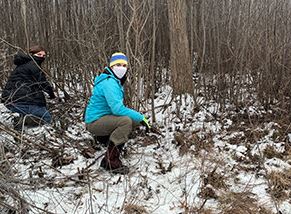Simple resolutions to enjoy, protect Michigan’s outdoors
By SARAH LAPSHAN
Senior communications advisor
Michigan Department of Natural Resources
Spending more time with family and friends, exercising more, learning a new skill or hobby, saving money, living life to the fullest – according to GoSkills.com, these are among the top 10 most common resolutions people make as the calendar flips to a brand new year.
 All are perfectly respectable goals, but why not shake things up a bit and resolve to take action that’s good for both you and the world around you? We’ve got some ideas to get you started. All are perfectly respectable goals, but why not shake things up a bit and resolve to take action that’s good for both you and the world around you? We’ve got some ideas to get you started.
Choose native plants, trees and shrubs
It’s not too early to start thinking about spring tree planting. An easy way to ensure you’re planting native, regional trees and shrubs that are most likely to thrive where you live is to work with your local conservation district or nature center, according to Ed Shaw, Carl T. Johnson Hunting and Fishing Center interpreter and coordinator of the Michigan Department of Natural Resources’ Outdoor Skills Academy.
“Genetic diversity in trees is just as important as it is among fish and wildlife species,” Shaw said. “Now is when you want to get your orders in, too, because it gives the conservation districts and nature centers time to place their orders.”
Visit MACD.org to find your district, learn about programs, place an order and get on the mailing list. When spring comes around and you do plant new trees, drop a pin in our interactive map to add your trees to our statewide count that’s part of the Trillion Trees Campaign.
Support forests of all ages
Say the word “forest” and most people think of thick stands of mature trees that stretch to the sky. If you’ve been to the Porkies in the western Upper Peninsula’s Porcupine Mountains Wilderness State Park or Hartwick Pines in Grayling, you’ve seen true gems – some Michigan trees are hundreds of years old. But these old-growth forests alone aren’t enough to support the fish and wildlife that depend on them for food and shelter.
Craig Kasmer is the interpreter at Hartwick Pines State Park. Over the years he has talked with tens of thousands of visitors about the value of different tree types and ages.
“Some 65% of the 20 million acres of forest land in Michigan is privately owned,” he said. “Most private forest landowners don’t like to cut trees, and I get that, but we have to have forests of different ages to provide the different habitat that different species need to survive.”
Kasmer said that if all private landowners do nothing to create young, successional forest types, there is a whole slew of species that are going to be lost – and we’ll wind up with only birds and animals that like to live in old-growth forests. The Kirtland’s warbler, for example, only nests in jack pine forests that are 5-20 years old. |
 If you or someone you know owns private forest land, consider working with a forester to develop a plan for your forest. Explore the DNR’s resources for private forest landowners to learn more about the Forest Stewardship and Forest Legacy programs. If you or someone you know owns private forest land, consider working with a forester to develop a plan for your forest. Explore the DNR’s resources for private forest landowners to learn more about the Forest Stewardship and Forest Legacy programs.
Be a savvy searcher
We get it. Spending a day outdoors is a treat, and sometimes you want to take home a little something you find there. In most cases that’s OK, but when foraging for wild foods, make sure you know ahead of time what you can take and what needs to stay.
Wild berries and mushrooms? Enjoy! Wildflowers? Leave them there, said Shaw, especially if a bloom is on the protected, endangered or threatened list; check out the Michigan Natural Features Inventory rare plants list for more information.
“We want everyone to enjoy the wildflowers,” Shaw said, “but leaving them where they are is the best choice. It also supports critical pollination processes that so many species rely on.”
No matter what you’re looking for – morels, sap for maple syrup, berries or something else – visit the DNR’s foraging webpage. It has the facts on what is permitted for harvest (and where), what to leave in the wild to protect sensitive and rare species, and how to safely prepare anything you plan to eat.
Be a history hero
During any visit to state-managed lands, including shorelines and bottomlands, please respect historic structures and sites and leave in place any artifacts you may find. Everyone shares a responsibility to protect historic places.
While recreational metal detecting for modern objects is allowed on some state-managed lands, historic artifacts are protected. It’s always illegal to remove them without the proper permissions. Disturbing or moving artifacts can quickly damage or destroy our archaeological heritage. If you think you’ve found something old and possibly historic, leave it in place, don’t disturb the area, and report the find to local staff and DNR archaeologists at [email protected]. |
 “Say you find an old crosscut saw on the ground or buried just below the surface, keep it right there, because next to that could be a button or bottle – something not picked up by the detector, but together those artifacts could tell the story of a camp here that we didn’t even know about,” said Stacy Tchorzynski, archaeologist and historian with the DNR’s Michigan History Center. “Knowing what to do in such a situation, to stop, protect and report finds, can help save important pieces of Michigan history, ensuring those stories can be interpreted and shared with future generations.” “Say you find an old crosscut saw on the ground or buried just below the surface, keep it right there, because next to that could be a button or bottle – something not picked up by the detector, but together those artifacts could tell the story of a camp here that we didn’t even know about,” said Stacy Tchorzynski, archaeologist and historian with the DNR’s Michigan History Center. “Knowing what to do in such a situation, to stop, protect and report finds, can help save important pieces of Michigan history, ensuring those stories can be interpreted and shared with future generations.”
Discover CCC connections
Many people who visit Hartwick Pines have some understanding of the role played by the Civilian Conservation Corps in building our state’s infrastructure and structures, including within state parks. If one of your relatives was among the 100,000-plus young Michigan men enrolled in the federal Depression-era Civilian Conservation Corps, head to Roscommon!
“Hillary Pine, who manages the Higgins Lake Nursery and CCC Museum and Nursery, not too far south of Hartwick Pines, said every year there are a lot of folks who come in and say, ‘You know, my great-grandfather was in the CCC …,’” said Kasmer. “If you know what camp your relatives were at, you can go to the museum in Roscommon and look through the panels of pictures to find them. It’s great to see those connections happen.”
If you want to explore even more Michigan history, add other museums and historic sites to your list of “must see” destinations for 2023. Start at Michigan.gov/MHC/Museums.
Know your invasives
Kasmer, while recently visiting the metro Detroit area, noticed that both sides of the road he was on were full of phragmites – that tall, grayish-green, invasive reed that seems to crop up everywhere – but he remembered knowing it by another name.
“As I kid, I was told that was bullrush,” he said. “I bet a lot of people learned it the same way, and there wasn’t much discussion then about what an invasive species even was, or why it posed a problem. Now, though, we see how invasive species can cause deforestation, reduce fish populations and alter valuable habitat. We see all too clearly the problems they cause.”
Invasive species are plants, animals and other organisms that aren’t native to Michigan and whose introduction harms, or is likely to harm, the state’s economy, environment or human health. The good news is that anyone, anywhere in the state can make a difference in the fight against these land and water invaders, just by knowing what to look for and reporting what you see.
Visit Michigan.gov/Invasives to learn more about identifying and reporting problem species; get tips on actions hunters, anglers, boaters and others can take to reduce the spread of invasives; and explore the popular NotMiSpecies webinar series. It covers everything from rock snot (yes, a true aquatic invasive species) to protecting your own backyard or neighborhood from damaging bugs like spongy moth or spotted lanternfly.
Start a new tradition
Always wanted to try fishing, hunting, hiking, birding, snowshoe building or other ways to connect with nature, but not sure where to start? The DNR’s Outdoor Skills Academy may have just what you need: expert-led outings, all the gear, and time and space to let yourself learn. |
 “Sometimes a lack of experience with a certain hobby or skill can be intimidating, but the Outdoor Skills Academy removes all of that,” said Shaw, who oversees the program. “Spend a weekend with your son or daughter, husband, wife or best friend, and enjoy diving into something new that might just become a lifelong passion.” “Sometimes a lack of experience with a certain hobby or skill can be intimidating, but the Outdoor Skills Academy removes all of that,” said Shaw, who oversees the program. “Spend a weekend with your son or daughter, husband, wife or best friend, and enjoy diving into something new that might just become a lifelong passion.”
Make time for the outdoors
In 2021, Kasmer said he noticed a lot more families heading north to view Kirtland’s warblers in the young jack pine forests. Many said the motivation for their trip actually stemmed from having time at home the year before – a rare benefit of the COVID-19 pandemic – giving them a chance to stop and watch their bird feeders.
“They said their kids would ask, ‘What’s that bird, and what’s that one?’ and it sparked a whole new interest in knowing more about what’s around them,” Kasmer said.
“The more you know about plants, fish and animals, the more you tend to care about their health and survival,” he said. “Sometimes that’s the first step toward having a more deliberate conservation mindset. Jacque Cousteau said people protect what they love, and it’s true. You start thinking about what small actions you can take to better protect these amazing natural resources.”
Though the pandemic is still part of the landscape, life has (mostly) returned to normal. Kasmer said he hopes people will hold onto that desire to carve out opportunities to relax, reconnect and explore the outdoors.
Consider these other conservation-minded resolutions to round out your year:
- Spend more time discovering Michigan state parks, trails and waterways (don’t forget your Recreation Passport).
- Fish the Great Lakes or thousands of inland lakes. Visit gov/Fishing for suggestions on where to fish, license information and more.
- Take advantage of local, regional and state trails, parks and nature centers in your area. Many offer educational programs perfect for all ages.
- Discover new ways to support the natural and cultural resources you value. Visit gov/DNRvolunteers for dozens of volunteer opportunities.
|
Check out previous Showcasing the DNR stories in our archive at Michigan.gov/DNRStories. To subscribe to upcoming Showcasing articles, sign up for free email delivery at Michigan.gov/DNREmail.
Note to editors: Contact: John Pepin, Showcasing the DNR series editor, 906-226-1352. Accompanying photos and a text-only version of this story are available below for download. Caption information follows. Credit Michigan Department of Natural Resources, unless otherwise noted.
Text-only version of this story.
Kirtland’s warbler in jack pine: Different species and age classes of trees provide the best habitat for different wildlife species, like the Kirtland’s warbler, shown here, which prefers to nest in young jack pine forests.
Morels: Foraging for wild mushrooms, like the sought-after morels, is a popular thing to do on public lands. Before you head out, make sure you know the harvest, access and safety guidelines.
Artifacts: While recreational metal detecting for modern objects is allowed on some state-managed lands, historic items like these Native American artifacts are protected. If you uncover something like this, leave the site undisturbed and email [email protected].
CCC Museum: If any of your relatives were part of the Civilian Conservation Corps that helped build infrastructure and structures in Michigan, including at state parks, plan a visit to the CCC Museum in Roscommon to explore these connections.
Making snowshoes: If you’re looking for a new outdoor tradition, try one of the many classes and workshops – like making your own snowshoes – offered through the DNR’s Outdoor Skills Academy.
Detroit River trail: Whether you live in a rural area or a more urban setting, there are a variety of local, regional and state recreation resources available, including paved trails like this one along the Detroit River.
Volunteer: There are many ways to lend a hand in support of your favorite natural and cultural resources. For example, there are dozens of opportunities to help at stewardship workdays at state parks across southern Michigan – like this young man helping remove dame’s rocket at Brighton Recreation Area. |










 All are perfectly respectable goals, but why not shake things up a bit and resolve to take action that’s good for both you and the world around you? We’ve got some ideas to get you started.
All are perfectly respectable goals, but why not shake things up a bit and resolve to take action that’s good for both you and the world around you? We’ve got some ideas to get you started.
 If you or someone you know owns private forest land, consider working with a forester to develop a plan for your forest. Explore the
If you or someone you know owns private forest land, consider working with a forester to develop a plan for your forest. Explore the  “Say you find an old crosscut saw on the ground or buried just below the surface, keep it right there, because next to that could be a button or bottle – something not picked up by the detector, but together those artifacts could tell the story of a camp here that we didn’t even know about,” said Stacy Tchorzynski, archaeologist and historian with the DNR’s Michigan History Center. “Knowing what to do in such a situation, to stop, protect and report finds, can help save important pieces of Michigan history, ensuring those stories can be interpreted and shared with future generations.”
“Say you find an old crosscut saw on the ground or buried just below the surface, keep it right there, because next to that could be a button or bottle – something not picked up by the detector, but together those artifacts could tell the story of a camp here that we didn’t even know about,” said Stacy Tchorzynski, archaeologist and historian with the DNR’s Michigan History Center. “Knowing what to do in such a situation, to stop, protect and report finds, can help save important pieces of Michigan history, ensuring those stories can be interpreted and shared with future generations.”
 “Sometimes a lack of experience with a certain hobby or skill can be intimidating, but the Outdoor Skills Academy removes all of that,” said Shaw, who oversees the program. “Spend a weekend with your son or daughter, husband, wife or best friend, and enjoy diving into something new that might just become a lifelong passion.”
“Sometimes a lack of experience with a certain hobby or skill can be intimidating, but the Outdoor Skills Academy removes all of that,” said Shaw, who oversees the program. “Spend a weekend with your son or daughter, husband, wife or best friend, and enjoy diving into something new that might just become a lifelong passion.”




 Anglers will soon benefit from the 624,205 fish, which collectively weighed 7.8 tons, that were stocked by the Michigan Department of Natural Resources at 85 locations across the state.
Anglers will soon benefit from the 624,205 fish, which collectively weighed 7.8 tons, that were stocked by the Michigan Department of Natural Resources at 85 locations across the state.

